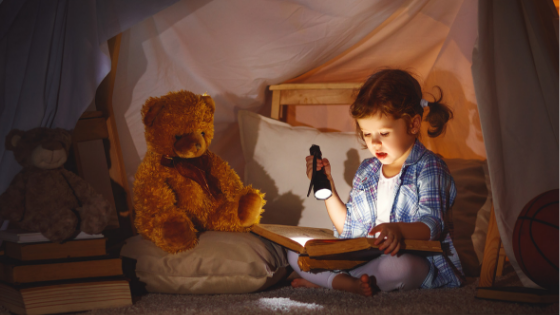

Disclosure: Some of the links in this article are affiliate links, which means that if you purchase through those links I will receive a small commission. For example, as Amazon Associate, I earn from qualifying purchases. If you decide to use these links, thank you!
Sleep difficulties are the worst. At the end of a long day the last thing you want to do is battle your child at bedtime. I always pictured myself gently tucking in my daughter at night and then quietly closing the door as she drifts off to sleep. This is far from reality.
We have experienced all of the typical bedtime struggles. Some of these include: avoiding sleep by asking for things (a snack, another story, a drink, etc), kicking and screaming while being tucked in, coming into our room multiple times per night. These sleep difficulties among others have led to a lack of much needed sleep and patience. While working as a school psychologist I compiled a stash of strategies to help with sleep difficulties that I would love to share with you.

In my previous post, Proven Ways To Improve Your Child’s Sleep Hygiene, I explained the essential sleep hygiene tips for you and your family. I would highly recommend that you read that post first and try those method prior to trying out the strategies in this post.
Some kids just have a harder time relaxing and falling asleep than other children. There are some nights when our daughter is so wound up and chatty that I don’t think any of us are every going to sleep. Another culprit is being over-tired. The research shows that when adults and children get over-tired, you have to keep yourself going by releasing stress hormones like cortisol and Adrenalin into your bloodstream. This leads to sleep difficulties. So what can we do when our child is not able to fall asleep?

Solution: Incorporate calming sensory activities into your child’s bedtime routine. Some activities to try include rocking in a rocking chair, a weighted blanket or heavy quilt folded up to increase weight and pressure, place a warm rice pillow in bed or try a Cozy Plush microwaveable stuffed animal. Other ideas include a massage, provide them with a squeeze ball to squeeze as they fall asleep, or bedtime yoga. As with all sensory activities, make sure not impose them on your child. Just present them and see if he/she responds.
Solution: Physical activity during the day. Kids NEED to be physically active throughout the day to prevent sleep difficulties. The research shows that kids really do sleep much better when they’ve had an hour or three to run around outside and breathe fresh air.
Solution: Avoid or reduce naps if possible. Daytime naps often interfere with nighttime sleep. If your child is outgrowing his need for naps, limit nap length or eliminate them and get him to bed earlier at night.
Solution: Essential oils for relaxation and sleep. You can place these fragrant oils can in a diffuser or put a few drops on your pillow at night. You could also add a calming aromatherapy scent to your child’s bath water. Lavender oil has been found to alleviated stress and improve sleep quality (source). Valerian root and bergamot essential oil also have a calming effect. Young Living has created a special kid friendly blend called SleepyIze for a peaceful aromatic environment.
Fear of the dark, monsters in the closet, or simply anxiety about going to bed are all relatively common in young children at some point during their childhood.
Solution: Listen to your child. What is your child afraid of? Begin by identifying the fear. Ask open-ended questions to allow your child to tell you what makes him or her scared at bedtime. Don’t make fun of your child’s fears. What may seem funny or trivial to you is very real to your child.
Solution: Do not support belief in your child’s imaginative creatures. Even stating that you will somehow destroy “the creature” confirms for your child that the creature does exist. This delays bedtime rather than provides comfort.
Solution: Reassure your child’s safety. If your child has a hard time being separated from you, reassure him or her, but then tuck your child back into his or her own bed. Telling your child to stay in his or her own bed and that everything is okay will teach your child to trust that his or her own bed is a safe place to be and keep them from leaving their bedroom.
If your child is extremely frightened and you believe they cannot tolerate being in their room alone, it is okay to occasionally stay by their bed until they fall asleep. It is not recommended that this happen too often, or even two nights consecutively, as your child may come to depend on your presence. If your child is anxious about being left alone, let them know you will check on them periodically. Begin by briefly checking and reassuring in 5 minutes, then 10 minutes, then 15 minutes, then 20 minutes until your child is asleep. Be careful not to spend much time during the period of reassurance.

Solution: Play fun games during the daytime that will make your child more comfortable when the lights are out. For example, give her a flashlight and let her hunt for a few stuffed animals in her room. You can go with her the first couple of times, but then coax her to go it alone as she becomes more comfortable. Or, you can turn all the lights off and read with a flashlight. Every kid loves a flashlight!
Solution: Provide your child with a nightlight. If your child asks to sleep with the light on, I would recommend using a Himalayan salt lamp. It emits a soft, warm glow that is much more relaxing than the harsh glare of regular lamps and overhead lights.
All parents know about bedtime delay tactics. You tuck your child in and suddenly they need a drink, they are hungry, they need to find a special toy for tomorrow, they want one more book. Then there are the kids that pop out of bed within five minutes of being tucked in. All of these scenarios are frustrating, but luckily, there are solutions!
First, I want to say do not lock your child in his room. Locking the door may be scary for your child. The goal is to teach your child to stay in bed, not punish or scare him.
Solution: A bedtime pass. A bedtime pass is a useful tool for ending delay tactics and getting out of bed (source). This bedtime pass is a card (or other object) that your child can present to you if he/she wakes at night. Your child may use it to trade for something brief, such as a quick hug or a drink of water.
Your child should be taught that they may only use the pass one time during the night, and that once the pass is used, it will be given to you. You will return the pass to the child the following night to use again. If your child comes out of their room after the pass has been used return your child to bed without providing attention (eliminate eye contact and verbal responses).
Teach your child that if the pass is not used all night, it can be traded for a morning present. You can also set up a reward system. For example, for every night the child does not use the pass, he/she gets a sticker. If your child collects a certain number of stickers (e.g. five) they receive a special gift. The presents can be dollar store items or a special outing with you.
Solution: Stoplight method. Another variation, which our daughter liked, is the stoplight method. What we did was print a stoplight on paper and asked our daughter to color it with green, yellow, and red. We attached a clip to the side and hung it up in her room next to her reward chart. The clip started on green, however, if she came out of her room at night the clip would get moved to yellow. If she came out of her room again, the clip was moved to red.
In the morning we checked the stoplight and if it was on green or yellow she would get to celebrate and put a sticker on her reward chart. If she was on red she would not receive a sticker. We didn’t bring too much attention to the fact that she did not earn a sticker. The focus is more on earning it for the following day.

Click on the image below to download a free PDF version of three printable reward charts.
When should a call to the doctor be considered?
Consider calling your doctor if:
I hope these sleep solutions help you and your family with your sleep difficulties. Please share the goodness and click on an image to pin or share on Instagram and Facebook and hashtag it #tonsofgoodness. Thank you!